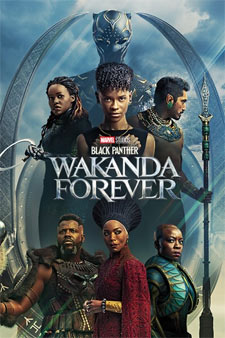
Black Panther: Wakanda Forever

 – for sequences of strong violence, action and some language.
– for sequences of strong violence, action and some language.
Director: Ryan Coogler
Starring: Letitia Wright, Tenoch Huerta, Angela Bassett, Lupita Nyong’o, Danai Gurira, Winston Duke, Dominique Thorne, Martin Freeman
Running Time: 2 hours, 41 minutes
Theatrical Release Date: November 11, 2022
Digital Release Date: February 1, 2023
Plot Summary
The people of Wakanda fight to protect their home from intervening world powers as they mourn the death of King T’Challa. (from IMDB)
Film Review
The untimely death of Carrie Fisher had sent Disney’s Star Wars sequel trilogy into a tailspin, which drastically changed their original plan for the third and final film in the series and saga, Episode 9. This led to a change in directors and an entirely new script, abandoning the film’s (and series’) original intended trajectory. In 2020, Marvel experienced a similar problem with the shocking loss of beloved Black Panther actor Chadwick Boseman. Unbeknownst to nearly everyone, the 43-year-old actor had been battling colon cancer for four years before he finally succumbed to the illness. This left Disney – and Marvel – again having to figure out what to do with the character and the announced Black Panther sequel.
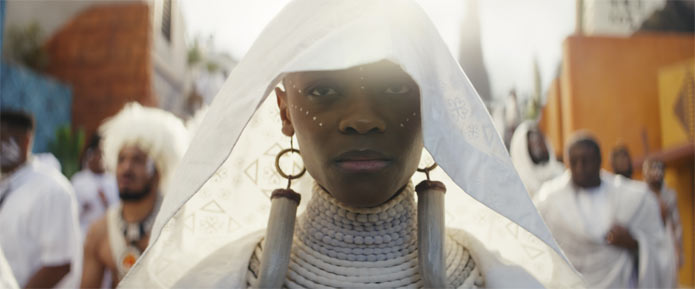
In short, Marvel decided not to recast T’Challa, the Black Panther hero, but decided to continue moving forward with its first sequel. Boseman had starred as T’Challa in four films — Captain America: Civil War, Black Panther, Avengers: Infinity War and finally in 2019’s Avengers: Endgame. Boseman would go on to posthumously reprise his role as T’Challa in animated form, featuring his voice, in the Disney+ series, What If?, concluding his run as the Black Panther. It was made widely known that the Black Panther sequel would deal with Boseman and T’Challa’s death, crown a new Black Panther, and continue the series from there. And with that, Black Panther: Wakanda Forever was born.
Black Panther: Wakanda Forever opens immediately with Letitia Wright’s Shuri, T’Challa’s scientifically brilliant sister, scrambling in the lab to make a cure for T’Challa’s unnamed illness. We never see T’Challa/Boseman, but only see the incident from Shuri’s point of view. After his passing, when we get to the opening Marvel credits, there’s absolutely no sound – no Marvel theme of any kind – and all of the hero imagery has been replaced with images of Chadwick as T’Challa / Black Panther. The normally-red Marvel logo is then shown as purple, the Wakandan royal color. This somber beginning, which left our respectably full afternoon theater in complete silence, set the tone for the next 2 hours and 40 minutes of Black Panther: Wakanda Forever.
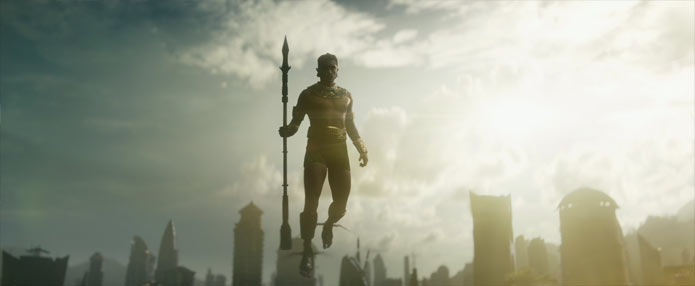
Understandably, Black Panther: Wakanda Forever follows T’Challa’s surviving family – his sister Shuri and his mother, Ramonda, who is now Wakanda’s queen. A year passes after the death of the beloved hero, and Shuri is still struggling with the loss of her brother, blaming herself for not being able to save him. The emotion of Wakanda Forever is real and palpable; anyone who was a fan of the character or Boseman already have had to deal with the shock of his loss, but Wakanda Forever digs in and really makes the viewer feel the weight of the character’s passing. The love the filmmakers and cast had for Boseman is also tangible. This isn’t a light movie by any means. Writer and director Ryan Coogler spends ample time allowing the audience to mourn along with Shuri and Ramonda, and showing just how impactful this is on their characters, the MCU, and Wakanda. But heaven knows that life doesn’t usually slow down just to allow people to mourn, and a new threat is introduced in Namor, played by Tenoch Huerta, an underwater mutant who leads a previously undiscovered underwater civilization. It makes for some different set pieces, action, and some impressive visuals, but also an action-packed finale that doesn’t really add up to the satisfying payoff the movie sets up for.
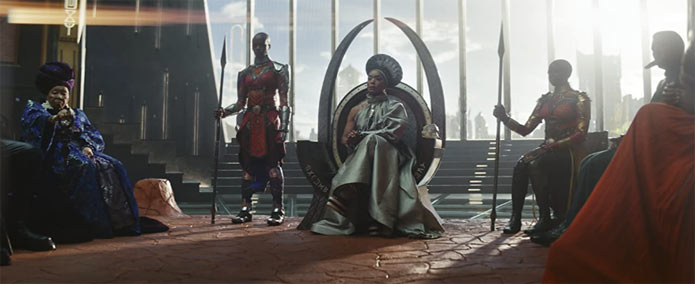
In some aspects, the near-3-hour runtime moves quickly, but you do start to feel it around the last act of the movie. I actually found myself looking forward to it ending. Yeah, that’s a not a good thing to say about a movie, but it ultimately feels like Coogler has the core movie he wanted to make here, with obligatory MCU setups forced into it. For example, to sort of setup the film’s MacGuffin, the story introduces another teenage genius, Riri Williams, who modern Marvel comics fans will know instantly as being Iron Heart, a post-Tony Stark Iron Man. Her introduction makes sense for the plot – even if it feels extremely convenient – but it gives Wakanda Forever the job of having to introduce and develop yet another character, who already has a planned future in the MCU franchise (with a forthcoming Disney+ TV series). And it also means that our heroes have to protect her at all costs. Riri’s character is fine, but it is definitely bittersweet to have a new iron-suited hero to replace Iron Man. The setup here doesn’t at all seem to give Riri any kind of motivation for copying Iron Man (I don’t think she mentions Tony or Iron Man even once), but I assume that will get explored in future Iron Heart stories. Her revealed suit design is also over-the-top with the heart symbolism, with its end design looking more like something a 7-year-old girl might scribble in crayon than something designed by a brilliant college student. Nitpicks aside, it’s a delight to have the return of Martin Freeman’s Agent Ross, but somehow the revelation that he has a connection to a recent new character just feels forced and ridiculously convenient (even if I do really enjoy that mysterious character and the person who plays them). Still, Coogler makes sure to use these tools to his story’s benefit, while checking off the boxes the MCU needs to keep the overarching story progressing forward. He even uses these other side plots to illustrate other character’s integrity and personal growth, which helps it all feel less disjointed.
When we met Shuri in Black Panther, she was a spunky, confident, and kind of childish teenager, who had a playful and endearing relationship with her older brother. Her journey here feels all too real, as her experience with loss forces her to grow up faster than she should have to, and helps her deal with, and hopefully overcome, some really heavy issues. Sure, her story may start to feel a little like Peter Parker’s in a way (any of the Peters, really, particularly Andrew Garfield’s), but Letitia Wright’s performance is wonderful and it’s hard not to love her character throughout this journey.
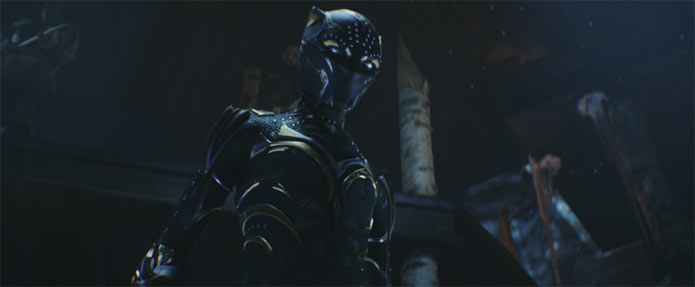
The content for Black Panther: Wakanda Forever is similar to the 2017 film, but definitely a lot less bloody. There are a handful of cuss words here and there, but they’re spread out over the course of its lengthy runtime, so it never feels excessive. Even still, I’d love for Marvel to cut back on it at some point. There isn’t really any sexual content, but knowing Disney’s current not-so-subtle agenda, there’s a super brief, and extremely random and unnecessary, moment near the film’s end where a Wakandan woman kisses the bald head of another Wakandan woman (who is seated) as she walks by, places her hand on her shoulder and refers to her as “my love” in a way that suggests they’re in a relationship together. It has no bearing on the story, and there’s no other suggestion of their relationship in any other part of the movie, so it feels like yet another box the studio is checking off for this movie. Nearly every Marvel movie since Avengers: Endgame (except for Black Widow, Shang-Chi and Spider-Man: No Way Home) has added gay characters to their movies and TV shows – whether it fits the story or not – and this feels especially forced in its execution. There’s quite a bit of violence, with characters being shot, stabbed, sliced or even impaled by spears, but it’s seldom graphic or bloody. We do, however, see a dying man in a flashback with blood on their face, an amphibious woman with a blue-bloody blaster wound on her abdomen (briefly), and a character who receives bloody scratches to their back and face. Otherwise, the movie deals heavily with the theme of death and loss, mourning, and moving past the loss of loved ones. There’s also a heavy moment when a character dies from drowning. One big action sequence shows a town being flooded and its inhabitants attacked, and the finale involves a big fight that shows characters getting sliced, stabbed, and thrown (but again, it’s seldom bloody).
Black Panther: Wakanda Forever may not be the sequel originally planned for the franchise, but it’s a very good one. I have to say I’m not sure how rewatchable this one will be, given how heavy in nature most of the story is – especially dealing with a major character’s death in T’Challa – but it’s most definitely the best Marvel movie of 2022, and proof that, despite all the recent hiccups, the studio can still make some good movies. Oh, if you do see the movie, do know there is a mid-credits scene, but nothing at all at the end of the credits.
– John DiBiase (reviewed: 2/4/23)
iTunes / Digital Copy Bonus Features Review
Black Panther: Wakanda Forever is now available via digital retailers (and streaming on Disney Plus) and will be releasing on 4K, Blu-ray and DVD discs soon. This movie was a bittersweet one as it had a solid story following the loss of Chadwick Boseman to serve as a transition and a passing of the torch, but it’s also kind of a downer at the same time. You kind of have to be ready for a heavy film when you tune into this one, and that makes it a less lighter Marvel experience. In its digital 4K form, the picture looks great, and it makes the move from silver screen to the small screen well.
With that said, along with the feature film, the iTunes digital copy of Black Panther: Wakanda Forever includes the following extras (which are shockingly minimal for such a big movie):
Envisioning Two Worlds (10:55) – The first featurette focuses on the task of expanding Wakanda, including showing an older section of the country that was inspired by real-life Zimbabwe. This segment also covers costume design, building large sets, the attention to detail and the cultures represented. The focus then shifts to Namor’s city, costume design and culture — and how their culture was largely inspired by the Mayans. Finally, they show us some water filming and how some scenes were done entirely with effects, while other scenes had the cast totally immersed in a tank.
Passing the Mantle (5:50) – Obviously, it was never part of the plan for Chadwick Boseman to pass away, leaving T’Challa without an actor to play him. This segment focuses on Shuri’s character growth from a child to a woman and picking up the mantle of Black Panther. Cast and crew address the idea of what inspires her character, while actress Letitia Wright (who plays Shuri) hopes to inspire people with her character. Finally, they also touch on how, this time around, Shuri goes from T’Challa’s little sister to playing the big sister role for Riri Williams.
Gag Reel (2:29) – This is pretty much your standard gag reel – especially for Marvel – but it’s still a pretty cute one. We see the cast goofing off, dancing between takes, and making mistakes. This one doesn’t have much by way of profanity, but there are still two bleeped-out “F” words.
Deleted Scenes (10:12) – There are four deleted scenes with a Play All option. First, “Outside the Scope” (2:47) is a sequence when Okoye goes rogue and sets out on her own. She’s then stopped by the Wakandan warriors and they threaten to fight her. Okoye stands down and leaves, and then one of the other women resign, too, in protest. The oddly titled “The Upstairs Toilet” (3:54) shows Agent Ross going undercover to infiltrate a building (and Martin Freeman gets to temporarily use his real British accent as he impersonates someone). I see why they cut it; it’s rather nnecessary, but it’s still a fun sequence. In “Daughter of the Border” (1:40), Okoye goes home and is asked to become queen of the border tribe. And finally, “Anytime, Anywhere” (1:34) takes place near the end of the film when Shuri goes to Haiti. When she arrives, Okoye shows up and says goodbye, but assures Shuri that she will always be there for her when she’s needed.
Lastly, there’s an option to Play Movie with Commentary by Ryan Coogler, Joe Robert Cole, and Autumn Durand Arkapaw (2:41:19) as a separate audio track.
– John DiBiase, (reviewed: 9/9/22)
Parental Guide: Content Summary
![]() Sex/Nudity: The women sometimes wear low-cut shirts with mild cleavage; A woman kisses the bald head of another woman, and suggestively refers to her as “my love”; We find out a woman has a son out of wedlock; A woman notices a man has gotten fit and makes a suggestive remark that she should come over and “hop on” his exercise machine; A woman gives birth underwater during a flashback and we see the umbilical cord floating in the water, still attached to the baby.
Sex/Nudity: The women sometimes wear low-cut shirts with mild cleavage; A woman kisses the bald head of another woman, and suggestively refers to her as “my love”; We find out a woman has a son out of wedlock; A woman notices a man has gotten fit and makes a suggestive remark that she should come over and “hop on” his exercise machine; A woman gives birth underwater during a flashback and we see the umbilical cord floating in the water, still attached to the baby.
![]() Vulgarity/Language: 9 “S” words, 6 “h*ll,” 4 “Oh my G-d,” 1 “a” word, 1 “Oh G-d,” 1 “p*ss off”
Vulgarity/Language: 9 “S” words, 6 “h*ll,” 4 “Oh my G-d,” 1 “a” word, 1 “Oh G-d,” 1 “p*ss off”
![]() Alcohol/Drugs: None.
Alcohol/Drugs: None.
![]() Blood/Gore: A blue amphibious woman is shot and we briefly see a bloody wound in her abdomen, with blue blood around it; A dying man in a flashback has blood on his face; A man’s face is cut with claws, and we see some bloody scratches on his face. He also gets claws dug into his bare back where we see some blood; A character is burned by a blast of fire on their bare back and we briefly see their charred back and legs.
Blood/Gore: A blue amphibious woman is shot and we briefly see a bloody wound in her abdomen, with blue blood around it; A dying man in a flashback has blood on his face; A man’s face is cut with claws, and we see some bloody scratches on his face. He also gets claws dug into his bare back where we see some blood; A character is burned by a blast of fire on their bare back and we briefly see their charred back and legs.
![]() Violence: Spoilers Ahead – Some amphibious people attack a ship, killing many people. We see some entranced men walk off a ship into water where they’re presumably drowned or killed; Armed soldiers infiltrate a base and blow open a vault where some Wakandan warriors emerge and subdue them; Three characters crash on a bridge, with two being in vehicle accidents. Two remain knocked out while one crawls out of an overturned car and fights a few amphibious warriors, nearly dying in the process. She thinks she kills several of the amphibious characters, but they get back up and run off. A water grenade knocks a person over a bridge into water while the other two are taken prisoner; We see a flashback of people taking a poisonous liquid that causes them to die and be reborn as amphibious creatures; A person infiltrates an underwater city and shoots a couple guards with a blaster, presumably killing one and wounding another; The amphibious people attack a city, causing a flood, and then many characters fight with spears to the death. A man is punched in his armored chest so hard it causes him to fly backward, shattering his armor (shown in slow motion); A spear is thrown into a glass window, cracking it; A couple water grenades floor a room, causing two people to sink underwater. One rescues the other and struggles to swim to the surface. We then see them floating facedown on the surface of the water. People pull them out and perform CPR on them, but they are declared dead; We see a vision of a room on fire; Black Panther and the Wakandans protect a ship that amphibious people crawl on with spears and fight the Wakandans with. They all swing around, swiping at each other with blades. There’s a large fight between the two groups on top of the ship; An amphibious person lodges a spear in the underside of the ship; Water grenades are detonated underneath the ship; A person is caught on a flying ship but they use a spear to break apart the ship and cause it to crash; A character fights another character in a brutal hand-to-hand fight where one rips part of the other person off (it’s not gory), and digs their nails into the back of the person (some blood). A fire burns the back of a person, charring their skin; A person is impaled by a spear. They then slowly pull themselves off of it (somehow, there’s no blood on the spear). They then nearly kill the other person with the spear but decide not to; and other comic book supehero violence.
Violence: Spoilers Ahead – Some amphibious people attack a ship, killing many people. We see some entranced men walk off a ship into water where they’re presumably drowned or killed; Armed soldiers infiltrate a base and blow open a vault where some Wakandan warriors emerge and subdue them; Three characters crash on a bridge, with two being in vehicle accidents. Two remain knocked out while one crawls out of an overturned car and fights a few amphibious warriors, nearly dying in the process. She thinks she kills several of the amphibious characters, but they get back up and run off. A water grenade knocks a person over a bridge into water while the other two are taken prisoner; We see a flashback of people taking a poisonous liquid that causes them to die and be reborn as amphibious creatures; A person infiltrates an underwater city and shoots a couple guards with a blaster, presumably killing one and wounding another; The amphibious people attack a city, causing a flood, and then many characters fight with spears to the death. A man is punched in his armored chest so hard it causes him to fly backward, shattering his armor (shown in slow motion); A spear is thrown into a glass window, cracking it; A couple water grenades floor a room, causing two people to sink underwater. One rescues the other and struggles to swim to the surface. We then see them floating facedown on the surface of the water. People pull them out and perform CPR on them, but they are declared dead; We see a vision of a room on fire; Black Panther and the Wakandans protect a ship that amphibious people crawl on with spears and fight the Wakandans with. They all swing around, swiping at each other with blades. There’s a large fight between the two groups on top of the ship; An amphibious person lodges a spear in the underside of the ship; Water grenades are detonated underneath the ship; A person is caught on a flying ship but they use a spear to break apart the ship and cause it to crash; A character fights another character in a brutal hand-to-hand fight where one rips part of the other person off (it’s not gory), and digs their nails into the back of the person (some blood). A fire burns the back of a person, charring their skin; A person is impaled by a spear. They then slowly pull themselves off of it (somehow, there’s no blood on the spear). They then nearly kill the other person with the spear but decide not to; and other comic book supehero violence.
